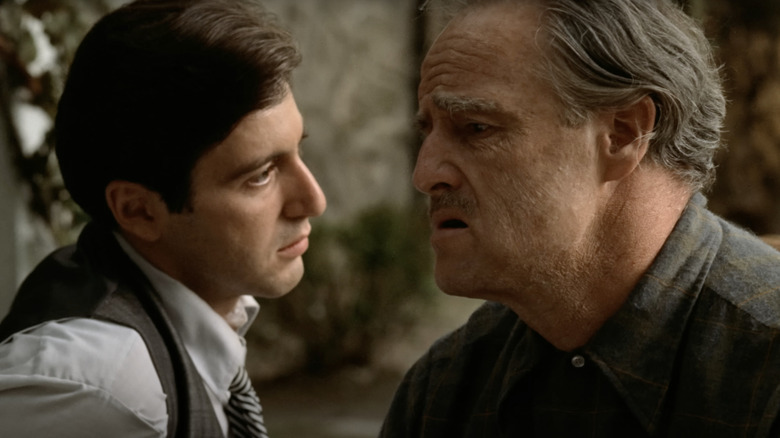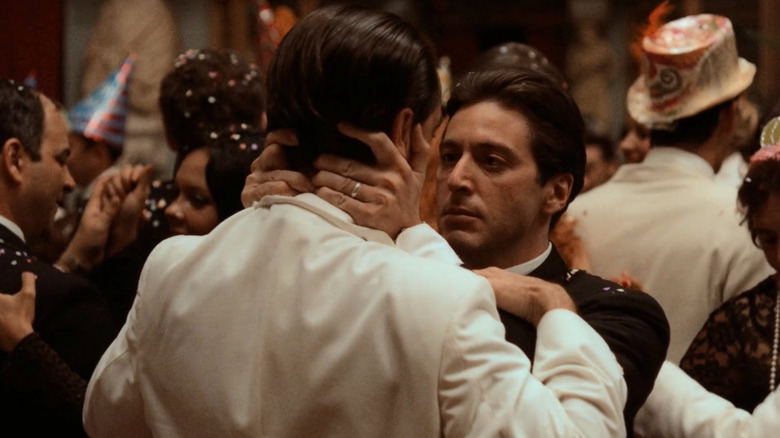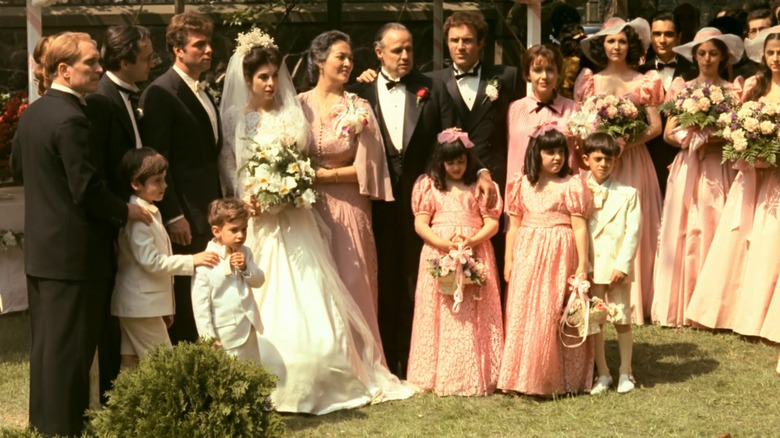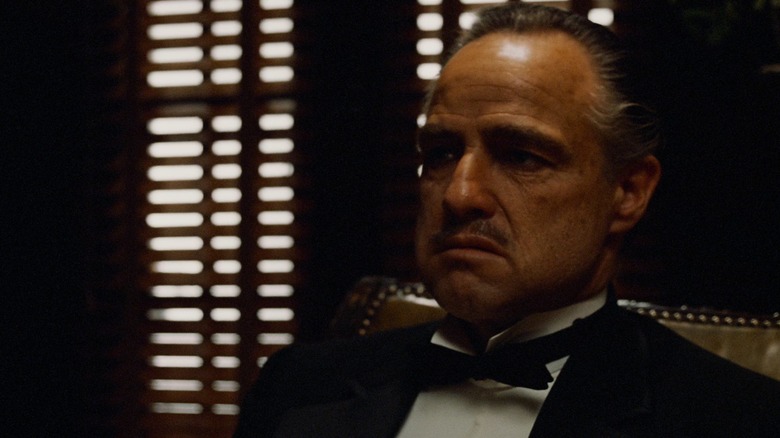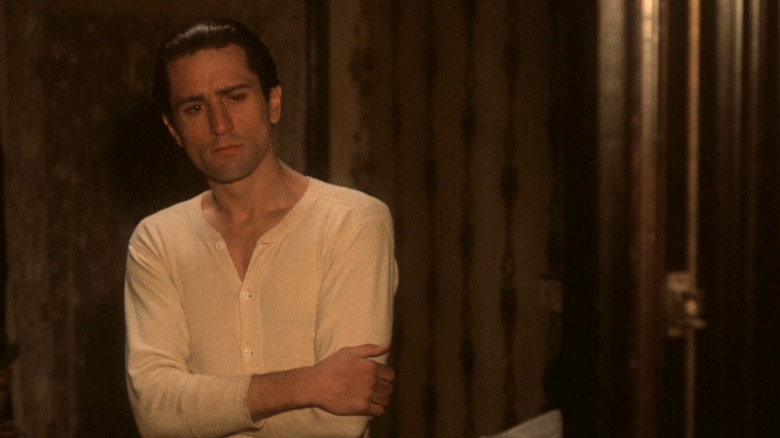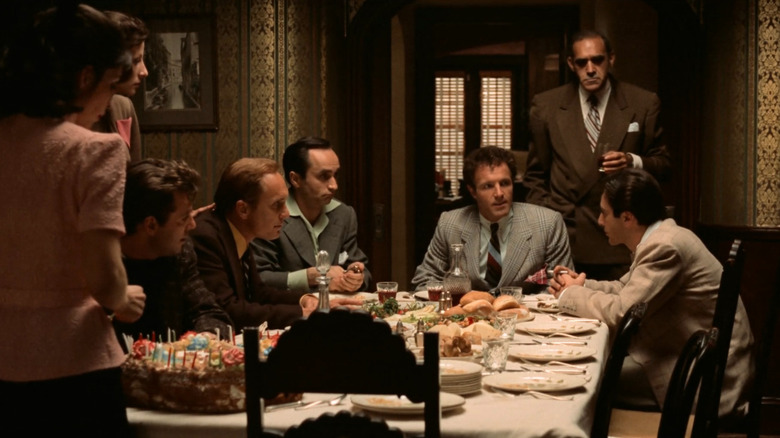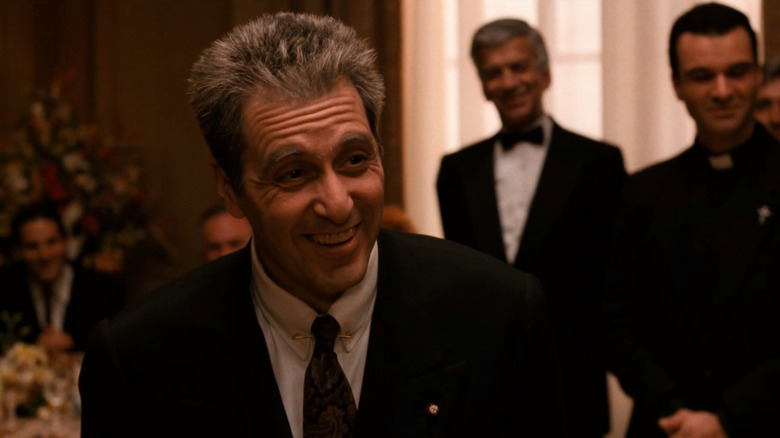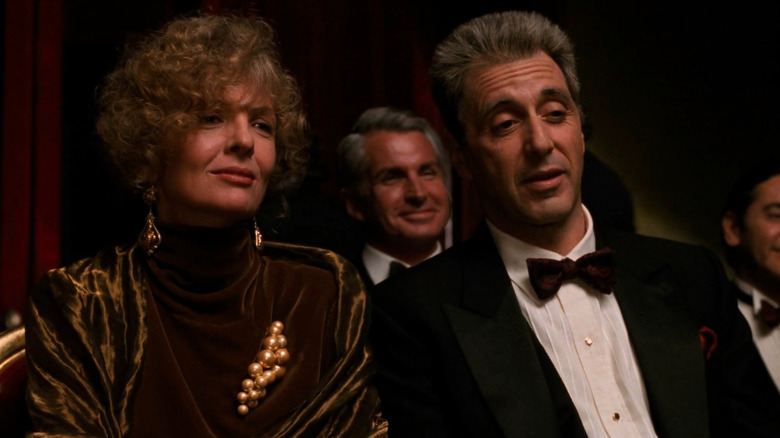The Daily Stream: The New And Improved Godfather Trilogy Is A Perfect Metaphor For Capitalism
(Welcome to The Daily Stream, an ongoing series in which the /Film team shares what they've been watching, why it's worth checking out, and where you can stream it.)
The Movies: "The Godfather," "The Godfather Part II," "The Godfather, Coda: The Death of Michael Corleone"
Where You Can Stream Them: Peacock
The Pitch: For my 56th and final entry in /Film's Daily Stream series, I thought, "Screw it. I'm gonna write about 'The Godfather.'"
When's the last time you did a full 9-hour marathon with all three movies? If asked to articulate why the first two are such masterworks, what would you say?
Until recently, I never had a good answer for that beyond the requisite plaudits for the cast and crew's artistry. It had been years since I revisited "The Godfather" trilogy, and the last time, I remember thinking it really is true that "The Godfather Part III" isn't as good as the first two. Sitting down to watch the 50th-anniversary 4K remaster of them this week — with the new 2020 edit, "The Godfather, Coda: The Death of Michael Corleone," switched out for the old "Part III" — I felt like I was seeing the movies for the first time.
Francis Ford Coppola never stopped tinkering with "The Godfather." Just when you think you're out, he pulls you back in. It started in 1977 when Coppola reedited the first two films, putting them in chronological order as "The Godfather Saga" for television. 1997 brought a 25th-anniversary THX remastering, and Coppola and Paramount Pictures were at it again in 2008 when they released "The Godfather: The Coppola Restoration." Months later, Coppola revealed to Vanity Fair that he initially didn't want to make "The Godfather" until he "found a deeper theme" in it as "a family chronicle" and "a metaphor for capitalism."
Why it's essential viewing
From its very first line — where the Sicilian undertaker, Bonasera (Salvatore Corsitto), looks at the camera and says, "I believe in America" — "The Godfather" positions itself as a national epic. Yet despite what Coppola says, or perhaps because of it, it's also a mob epic. How does one reconcile that with the national character? Is Bonasera saying he believes in freedom? Or is he talking about the land of business opportunity?
America, thy name be capitalism. From Coppola's lips to your ears, that's the thematic key that unlocked "The Godfather" for him, made it worth filming, and makes it now worth rewatching ad infinitum. Marlon Brando, too, saw it as a story "about the corporate mind." It's a family chronicle as well, like Coppola says, but in "The Godfather Part II," we see the limits of family for Michael Corleone (Al Pacino).
Spoiler alert for a famous, 49-year-old movie moment: Michael has his own brother, Fredo (John Cazale), killed in "Part II." That's Fredo's exit from the franchise, and Michael watches it happen from a window far across the lake where Fredo dies. Conversely, Fredo's first entrance in "The Godfather" comes at a wedding reception where he's up close and personal with Michael, right after Michael explains the family business to his girlfriend, Kay (Diane Keaton). Michael does that in a chilly, matter-of-fact way, which absolutely tracks with how his character develops in the first and second film.
It gets trickier in "Part III" when the stone-cold killer starts smiling again and they try to redeem Michael. That entails receiving absolution for all his past wrongs from a crooked church he's supported financially, as if he can buy his way into heaven and back into the viewer's heart.
What could be more American than that?
The Godfather: In the wedding shadows
The 26-minute wedding sequence that opens "The Godfather" shows a superficially happy occasion, where bright exteriors and singing guests are contrasted with the shadowy dealings going on in nearby rooms. Gordon Willis' moody cinematography continues to inspire low-lit prestige TV shows, all descended from "The Sopranos," which itself name-dropped Willis and repeatedly signposted "The Godfather" as an influence amid its characters' own "overt and covert" lives (as American Cinematographer called them).
Moreover, in the new 4K restoration of "The Godfather," the frames are almost oversaturated. It's like seeing the magic of digital photo enhancement take effect in reverse. Restored to its original vision, the movie looks crisp and clear, better than it ever has on home media. Yet with all this talk of America, seeing some tan faces rendered orangish onscreen recalls unwanted mental images of another thuggish, loyalty-demanding businessman: the celebrity real-world Americans elected to presidential office back in 2016.
We get to know the whole cast of characters at this wedding, and at least one of them, Sonny Corleone (James Caan), is not above having a secret upstairs rendezvous with his girlfriend while his wife's not looking. Before the movie is over we'll see Sonny's sister — the bride, Connie Corleone (Talia Shire) — suffer horrifying domestic violence from her groom while pregnant.
Elsewhere, "The Godfather" juxtaposes Christmas shopping with a bulletproof vest and garroting. Later, it juxtaposes a child's baptism with bloody mob assassinations. So many other scenes are just guys sitting and talking, strategizing, conducting formal business. Yet beneath the formality and the level-headed assurances of Tom Hagen (Robert Duvall) that even a father's near-death is "business, not personal," there's a tacit corruption. The cops are corrupt, and drugs are "a dirty business," but there's "money potential in narcotics." Get your money.
'Don't ask me about my business'
When you watch "The Godfather," there's no Marlon Brando. There's just Don Vito Corleone with his bulldog cheeks, wishing his business rivals luck — as long as their interests don't conflict with his. Early on, we learn how the magnanimous Don's "business" operates, as Michael tells Kay the "made him an offer he couldn't refuse" story. The dialogue paints a vivid picture, wherein Don Corleone's enforcer holds a gun to a man's head.
Michael: "My father assured him that either his brains or his signature would be on the contract. That's a true story. That's my family, Kay, it's not me."
We soon see firsthand how the Don, acting by proxy through Tom, strong-arms belligerent Hollywood producer Jack Woltz (John Marley) by beheading his beautiful horse and leaving them in a bed of blood together. In Coppola and Corleone's America (co-written by Mario Puzo based on his bestseller), this is how an effective businessman operates.
Woltz speaks of "dollars and sense," but he doesn't want Tom to think he's "a hard-hearted man," like Michael will become. Michael's own insistence that he's not his family belies how well-suited his cool demeanor makes him to lead. Contrast this with the hot-headed Sonny, who goes out in a hail of bullets.
Vito Corleone is also subject to offers he can't refuse. Forty-five minutes into the movie, he's gunned down in the street while shopping for oranges, leaving Michael to emerge as the true protagonist. What makes Vito a target is his resistance to narcotics and his refusal to share "all the judges and politicians in his pocket." Other racist old mob bosses, supposedly "reasonable men," want to control the drug trade and "keep it respectable" by confining it to "the coloreds." One blithely remarks, "We're not communists."
The Godfather Part II: Snipping the strings
Things get more political in "The Godfather Part II" as Michael heads down to Cuba, where a real communist revolution is happening. Hyman Roth (Lee Strasberg), a man who "always makes money for his partners," carves up pieces of Cuban real estate in tandem with his birthday cake.
In Lake Tahoe, Michael meets with Senator Geary (G.D. Spradlin), recognizing that they're "both part of the same hypocrisy," masquerading as "decent Americans." Darkness now descends even on the family gathering at the beginning, where Connie lingers as Michael's first sibling casualty. If there were ever any doubt that Tom Hagen is a bad guy, too, that evaporates when he says of a dead sex worker, "It'll be as though she never existed."
As Michael's face dissolves into the young Vito (Robert De Niro), we see a hard-working immigrant navigate a country that fleeces and fails its citizens. Cue the parade with money pinned to religious statues. A representative of the Black Hand wears white as he preys on the little man in Vito's neighborhood. This gets to the heart of the puppet-string logo: emblem for a nation of immigrants who sailed into Ellis Island like Vito, hoping to make a better life for themselves apart from the powerbrokers pulling the strings in the Old World.
After witnessing the unfair circumstances in his community — losing his job to nepotism when he's got a sick kid at home — Vito takes what life won't give him, stealing from the rich and killing his way to the top so he can be his own boss. In mob movies, "business" is usually code for crime; "The Godfather" inverts this by making crime code for business, as if to show how they can be one and the same in America.
'By being strong for his family, could he lose it?'
In a recent CNN appearance, Bryan Cranston, the star of "Breaking Bad" — one of those post-"Sopranos" riffs on a "Godfather"-type tale — discussed America's apparent inability to see "how it went wrong" in the past and learn from that. "400 years of slavery, yeah, but we're moving on," Cranston said (per The Hollywood Reporter).
Michael Corleone has a similar problem when it comes to reckoning honestly with his choices. Denial is a survival mechanism; it enables Michael to live with what he's become and stay strong in the face of adversity. We can see this pattern of stubborn human behavior in both his character arc and the real-life history surrounding "The Godfather," like the 45th Academy Awards, where people booed the late Sacheen Littlefeather as she declined Brando's Oscar for him in protest of Hollywood's treatment of Native Americans.
What makes the original "Godfather" duology such a tragedy is that it starts out as a family chronicle — a story about people living and working together — and ends with a man alone in a chair, so consumed by his ruthless business ideals that he was blind to his family's implosion. Michael recognizes that the mob, like Hollywood, is a racket where loyalty is based on business prosperity. But he goes along with it and keeps telling himself he'll change until everyone he ever really loved is either dead or shut out. (Kay again gets the door closed on her).
The story arrives at this moral in its sixth hour, and it's over by then. Roll credits. America, however, is the home of second chances, where we're inculcated at an early age to pursue happiness and all our elusive dreams to the bitter end. What, then, does a happy Michael Corleone look like?
From Part III to Coda
In "The Godfather, Coda: The Death of Michael Corleone," subtext becomes text. The viewer can no longer disassociate Michael as a mobster because he's now a legitimate businessman, "the new Rockefeller."
The movie opens by dropping us down in a different scene that originally came 39 minutes into "The Godfather Part III." Gone are the spider-web windows of the abandoned Corleone compound in Tahoe, along with the Twin Towers, the papal honors, and the flashback to Fredo's death. In their place are Saint Patrick's Cathedral and Michael's sit-down with Archbishop Gilday (Donal Donnelly), who explains that the church is "like any other company in the world." Another corrupt human institution.
It's a less elegant opening that nonetheless gets right down to business, true to capitalist form. At the reception (this time, all indoors), and later, in Sicily, it almost seems out of character for Michael to be cracking Tony Bennett jokes and reconnecting with Kay, as if his undeserved cheeriness evinces a monstrous falsity at the American dream's core.
Calling it "Coda" instead of "Part III" repositions the movie, now 12 minutes shorter, as an epilogue. Had Coppola (who admitted to making it for money) done it as a spiritual sequel instead of a direct continuation, like Pacino and Brian De Palma did with "Carlito's Way" after "Scarface," it might not suffer as much in comparison to two of the greatest films ever made.
"The Death of Michael Corleone" isn't a necessary supplement, but it's enough of a subtle improvement over "Part III" that we finally have the excuse we need to admit that — kissing cousin subplot notwithstanding — Sofia Coppola here is no worse than Keanu Reeves in "Bram Stoker's Dracula." If only the filmmakers hadn't made Robert Duvall a salary offer he could refuse.
The Death of Michael Corleone
Like his father, Michael makes no apologies for his life. He confesses without repenting ... but maybe he should. Though Michael renounces Satan in "The Godfather," he sold his soul long ago, betraying his ideals even while clinging to them. This is a road people and businesspeople all around the world travel every day as they struggle to get ahead and stay ahead. "Men always believe they won't fail," Michael tells Vincent Mancini (Andy Garcia), and it makes sense. Otherwise, why even bother trying?
The flip side of that is when the idealist becomes so much of a realist as to lose perspective of what's right and wrong. As "The Irishman" would prevaricate (and the word police wouldn't): "It is what it is." And what it is in "The Death of Michael Corleone" is the banality of boardroom evil. The boardroom just happens to be situated in Rome, which adds further literalization after Frank Pentangeli (Michael V. Gazzo) and Tom Hagen's "Part II" conversation, likening the Corleone family to the Roman Empire.
The new ending, which fades to black before Michael — frail and diabetic, "beyond redemption" — falls out of the chair, suggests his death is a living one. With the loss of his daughter on opera night, the damage wrought by Michael's actions finally boomerangs back and breaks him in the most personal way imaginable, dashing his hopes for his family's future and leaving him to inhabit an even deeper emotional crater than the one at the end of "Part II."
Stripped down to its root theme, "The Godfather" isn't a mob movie. It's a film about compromising one's principles for business. This is the dark side of the American dream, which found expression in "The Godfather" trilogy like no other movie before or since.
